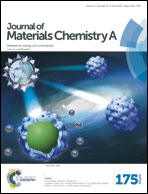Fully spray-coated organic solar cells on woven polyester cotton fabrics for wearable energy harvesting applications†
Abstract
This paper presents the novel use of spray-coating to fabricate organic solar cells on fabrics for wearable energy harvesting applications. The surface roughness of a standard woven 65/35 polyester cotton fabric used in this work is of the order of 150 μm and this is reduced to a few microns by a screen printed interface layer. This pre-treated fabric substrate with reduced surface roughness was used as the target substrate for the spray-coated fabric organic solar cells that contain multiple layers of electrodes and active materials. Fully spray-coated photovoltaic (PV) devices fabricated on fabric substrates have been successfully demonstrated with power conversion efficiency comparable to that of their glass based counterparts. All PV devices are characterised under simulated AM 1.5 conditions. Device morphologies were examined by scanning electron microscopy (SEM) and atomic force microscopy (AFM). This approach is potentially suitable for the low cost integration of PV devices into clothing and other decorative textiles.


 Please wait while we load your content...
Please wait while we load your content...